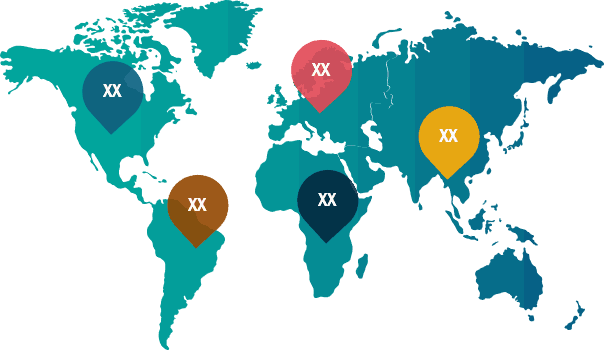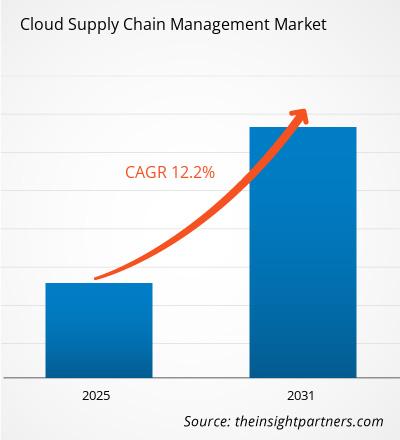クラウド サプライ チェーン管理市場は、2023 年から 2031 年にかけて 12.2% の CAGR を記録すると予想されています。新製品導入 (NPI) のスピードへの注目が高まることは、今後も市場の主要なトレンドであり続けると思われます。
クラウド サプライ チェーン管理市場分析
- クラウド サプライ チェーン管理市場には、現在の市場動向と予測期間中の予測可能な影響により、成長の見通しが含まれています。
- クラウド サプライ チェーン管理市場は、物流部門の大幅な成長、クラウド サプライ チェーン管理ソリューションの利点に関する認識の高まり、コスト最適化の必要性の高まりなどの要因により成長しています。
- AI を活用したノータッチ/ロータッチの計画により、クラウド サプライ チェーン管理市場に有利な機会を提供します。
クラウド サプライ チェーン管理市場の概要
- クラウド サプライ チェーン管理とは、オンサイトのハードウェアの代わりにクラウド コンピューティング サービスを使用することで、個人が商品の流れを監視できるようにするシステム、手順、およびツールを指します。
- これにより、どこからでもデータを入力してアクセスすることが可能になり、クラウドバックアップによる冗長性が提供され、サプライ チェーン データが常に最新の状態に保たれ、アクセス可能になり、紛失、損傷、盗難から保護されます。
要件に合わせて調査をカスタマイズ
弊社の標準サービスでは対応できない分析と範囲を最適化し、カスタマイズすることができます。この柔軟性により、ビジネス計画と意思決定に必要な正確な情報を得ることができます。
クラウド サプライ チェーン管理市場:戦略的洞察

CAGR (2023 - 2031)12.2%- 市場規模 2023年
XX百万米ドル - 市場規模 2031年
XX百万米ドル

市場の動向
- 物流部門の急成長、クラウドサプライチェーン管理ソリューションの利点に関する認識の高まり、コスト最適化の必要性の高まり
- ノータッチ/ロータッチプランニングを実現
- 新製品導入(NPI)のスピードへの重点強化
主要人物
- オラクル
- 財務諸表
- IBM
- クラウドログス
- クラウドエラ株式会社
- JDAソフトウェア株式会社
- キナクシス(カナダ)
- インフォア(米国)
- ブルーヨンダーグループ株式会社
- クーパソフトウェア株式会社
地域概要

- 北米
- ヨーロッパ
- アジア太平洋
- 南米と中央アメリカ
- 中東およびアフリカ
市場セグメンテーション
 成分
成分- 解決
- サービス
 展開モデル
展開モデル- 公共
- プライベート
- ハイブリッド
 組織規模
組織規模- 中小企業
- 大企業
 垂直
垂直- 食品・飲料
- ヘルスケアとライフサイエンス
- 製造業
- 小売・卸売
- 運輸・物流
- サンプル PDF では、定性的および定量的な分析により、コンテンツの構造と情報の性質が紹介されています。
クラウド サプライ チェーン管理市場の推進要因と機会
クラウドサプライチェーン管理ソリューションの利点に関する認識の高まりが市場を有利にする
- クラウド テクノロジーは、クラウドベースの管理ツールによって、サプライ チェーン管理の効率と革新を促進し続けています。これらのプラットフォームは比類のない拡張性と柔軟性を提供し、企業が変化する市場の需要に正確かつ迅速に適応できるようにします。
- サプライチェーン運用におけるクラウドベースの管理ツールの主な利点の 1 つは、コスト効率です。
- 組織は、クラウド ソリューションに移行することで、従量課金制でスケーラブルなリソースを取得し、従来の IT インフラストラクチャに関連する資本支出を最小限に抑えることができます。この経済モデルを利用することで、企業は運用コストを最大化し、支出を実際の消費量に合わせて、長期的な成功を達成できます。
- さらに、クラウドベースの管理プラットフォームは、サプライ チェーン エコシステム内の関係者間のシームレスなコラボレーションを促進します。チームは、共有ワークスペースと統合された通信テクノロジを利用して、活動を効果的に調整し、重要な情報を伝達し、リアルタイムで共同作業を行うことができます。
AI を活用したノータッチ / ロータッチ プランニング
- 回復力と ESG が継続的に重視され、拠点、フロー、パートナーが増加しているため、サプライ チェーンの計画は常にプレッシャーにさらされています。
- より複雑で多層的、かつ微妙な環境の要求は、現在の計画機能では対応しきれないほど大きくなっています。その結果、重要な選択の財務的影響を確認するための効率的なシナリオ分析を実行できる企業は多くありません。
- AI 対応の販売および運用計画 (S&OP) と統合ビジネス プランニング (IBP) アプリケーションは、サプライ チェーンの計画と実行の間のギャップを解消するのに役立ちます。
- ロータッチ プランニングでは、高度な分析を使用して、人間の関与を減らしながらより深い質問に答え、エンドツーエンドのプランニング プロセスから手作業の大部分を排除します。人工知能 (AI) は、大量のデータを評価し、異常を検出し、予期しない混乱を引き起こす傾向を探すことができます。
クラウドサプライチェーン管理市場レポートのセグメンテーション分析
クラウド サプライ チェーン管理市場分析の導出に貢献した主要なセグメントは、コンポーネント、展開モデル、組織規模、および垂直です。
- コンポーネント別に見ると、市場はソリューションとサービスに分かれています。
- 展開モデル別に見ると、市場はパブリック、プライベート、ハイブリッドに分類されます。
- 組織規模別に見ると、市場は中小企業と大企業に分かれています。
- 垂直別に見ると、市場は食品・飲料、ヘルスケア・ライフサイエンス、製造、小売・卸売、輸送・物流、その他に分類されます。
クラウド サプライ チェーン管理の地域別市場シェア分析
- クラウド サプライ チェーン管理市場レポートは、北米、ヨーロッパ、アジア太平洋 (APAC)、中東およびアフリカ (MEA)、中南米の 5 つの主要地理的地域の詳細な分析で構成されており、現在の市場規模と過去の市場規模、2021 年から 2031 年までの予測が含まれています。
- 各地域はさらにそれぞれの国に細分化されています。このレポートでは、18か国以上の分析と予測を提供し、地域レベルで市場に影響を与える推進要因、傾向、機会などのクラウド サプライ チェーン管理市場の動向を網羅しています。
- また、レポートでは、これらの地域のクラウド サプライ チェーン管理市場に影響を与える主要な要因の調査を含む PEST 分析も取り上げています。
クラウドサプライチェーン管理市場レポートの範囲
| レポート属性 | 詳細 |
|---|---|
| 2023年の市場規模 | XX百万米ドル |
| 2031年までの市場規模 | XX百万米ドル |
| 世界のCAGR(2023年~2031年) | 12.2% |
| 履歴データ | 2021-2023 |
| 予測期間 | 2024-2031 |
| 対象セグメント | コンポーネント別
|
| 対象地域と国 | 北米
|
| 市場リーダーと主要企業プロフィール |
|
- サンプル PDF では、定性的および定量的な分析により、コンテンツの構造と情報の性質が紹介されています。
クラウド サプライ チェーン管理市場のニュースと最近の動向
クラウド サプライ チェーン管理市場は、主要な企業出版物、協会データ、データベースなどの一次調査と二次調査後の定性的および定量的データを収集することによって評価されます。クラウド サプライ チェーン管理市場の動向のいくつかを以下に示します。
- SAP SE は、製造業の生産性、効率性、精度に変革をもたらすサプライチェーン ソリューションにおける AI の進歩を発表しました。リアルタイム データから得られる AI 主導の洞察により、企業はサプライチェーン全体で意思決定を最適化し、製品開発を合理化し、製造効率を向上させることができます。(SAP SE、プレスリリース、2024 年 4 月)
- 富士通は、サプライチェーン全体の荷主、物流会社、ベンダー向けに、クラウドベースの新しい物流データ標準化・可視化サービスを開始すると発表しました。このサービスは、迫りくるトラック運転手不足、輸送における二酸化炭素排出量削減の緊急の必要性、厳格化する業界規制への準拠など、さまざまな課題に対応し、業務の持続可能性を実現するための新しいツールを顧客に提供します。(富士通、プレスリリース、2023年12月)
クラウド サプライ チェーン管理市場レポートの対象範囲と成果物
「クラウドサプライチェーン管理市場の規模と予測(2021〜2031年)」レポートでは、以下の分野をカバーする市場の詳細な分析を提供しています。
- クラウドサプライチェーン管理市場の規模と予測(対象範囲に含まれるすべての主要市場セグメントの世界、地域、国レベル)
- クラウドサプライチェーン管理市場の動向、および推進要因、制約、主要な機会などの市場動向
- 詳細なPEST/ポーターの5つの力とSWOT分析
- 主要な市場動向、世界および、主要プレーヤー、規制、最近の市場動向を網羅したクラウドサプライチェーン管理市場分析
- クラウド サプライ チェーン管理市場の市場集中、ヒート マップ分析、主要プレーヤー、最近の動向を網羅した業界の状況と競争分析
- 詳細な企業プロフィール
- 過去2年間の分析、基準年、CAGRによる予測(7年間)
- PEST分析とSWOT分析
- 市場規模価値/数量 - 世界、地域、国
- 業界と競争環境
- Excel データセット


- Vertical Farming Crops Market
- Surety Market
- Small Molecule Drug Discovery Market
- Cling Films Market
- Water Pipeline Leak Detection System Market
- Hydrocephalus Shunts Market
- Redistribution Layer Material Market
- Microplate Reader Market
- Biopharmaceutical Contract Manufacturing Market
- Asset Integrity Management Market

Report Coverage
Revenue forecast, Company Analysis, Industry landscape, Growth factors, and Trends

Segment Covered
This text is related
to segments covered.

Regional Scope
North America, Europe, Asia Pacific, Middle East & Africa, South & Central America

Country Scope
This text is related
to country scope.
よくある質問
The report can be delivered in PDF/PPT format; we can also share excel dataset based on the request.
Some of the customization options available based on the request are an additional 3–5 company profiles and a country-specific analysis of 3–5 countries of your choice. Customizations are to be requested/discussed before making final order confirmation, as our team would review the same and check the feasibility.
Increased focus on the speed of new product introduction (NPI) is anticipated to play a significant role in the global cloud supply chain management market in the coming years.
The leading players operating in the cloud supply chain management market are Oracle; SAP; IBM; CloudLogix; Cloudera, Inc.; JDA Software Inc.; Kinaxis (Canada); Infor (U.S.); Blue Yonder Group, Inc.; and Coupa Software Inc.
The global cloud supply chain management market is expected to grow at a CAGR of 12.2% during the forecast period 2024 - 2031.
The huge growth of the logistics sector, growing awareness about the benefits of cloud supply chain management solutions, and the increasing need for optimizing cost are the major factors driving the cloud supply chain management market.
Trends and growth analysis reports related to Technology, Media and Telecommunications : READ MORE..
The List of Companies
1. BLUJAY SOLUTIONS
2. HIGHJUMP INC.
3. INFOR, INC
4. JDA SOFTWARE GROUP, INC.
5. KINAXIS
6. MANHATTAN ASSOCIATES
7. ORACLE CORPORATION
8. SAP SE
9. TECSYS, INC.
10. THE DESCARTES SYSTEMS GROUP INC.
The Insight Partners performs research in 4 major stages: Data Collection & Secondary Research, Primary Research, Data Analysis and Data Triangulation & Final Review.
- Data Collection and Secondary Research:
As a market research and consulting firm operating from a decade, we have published and advised several client across the globe. First step for any study will start with an assessment of currently available data and insights from existing reports. Further, historical and current market information is collected from Investor Presentations, Annual Reports, SEC Filings, etc., and other information related to company’s performance and market positioning are gathered from Paid Databases (Factiva, Hoovers, and Reuters) and various other publications available in public domain.
Several associations trade associates, technical forums, institutes, societies and organization are accessed to gain technical as well as market related insights through their publications such as research papers, blogs and press releases related to the studies are referred to get cues about the market. Further, white papers, journals, magazines, and other news articles published in last 3 years are scrutinized and analyzed to understand the current market trends.
- Primary Research:
The primarily interview analysis comprise of data obtained from industry participants interview and answers to survey questions gathered by in-house primary team.
For primary research, interviews are conducted with industry experts/CEOs/Marketing Managers/VPs/Subject Matter Experts from both demand and supply side to get a 360-degree view of the market. The primary team conducts several interviews based on the complexity of the markets to understand the various market trends and dynamics which makes research more credible and precise.
A typical research interview fulfils the following functions:
- Provides first-hand information on the market size, market trends, growth trends, competitive landscape, and outlook
- Validates and strengthens in-house secondary research findings
- Develops the analysis team’s expertise and market understanding
Primary research involves email interactions and telephone interviews for each market, category, segment, and sub-segment across geographies. The participants who typically take part in such a process include, but are not limited to:
- Industry participants: VPs, business development managers, market intelligence managers and national sales managers
- Outside experts: Valuation experts, research analysts and key opinion leaders specializing in the electronics and semiconductor industry.
Below is the breakup of our primary respondents by company, designation, and region:

Once we receive the confirmation from primary research sources or primary respondents, we finalize the base year market estimation and forecast the data as per the macroeconomic and microeconomic factors assessed during data collection.
- Data Analysis:
Once data is validated through both secondary as well as primary respondents, we finalize the market estimations by hypothesis formulation and factor analysis at regional and country level.
- Macro-Economic Factor Analysis:
We analyse macroeconomic indicators such the gross domestic product (GDP), increase in the demand for goods and services across industries, technological advancement, regional economic growth, governmental policies, the influence of COVID-19, PEST analysis, and other aspects. This analysis aids in setting benchmarks for various nations/regions and approximating market splits. Additionally, the general trend of the aforementioned components aid in determining the market's development possibilities.
- Country Level Data:
Various factors that are especially aligned to the country are taken into account to determine the market size for a certain area and country, including the presence of vendors, such as headquarters and offices, the country's GDP, demand patterns, and industry growth. To comprehend the market dynamics for the nation, a number of growth variables, inhibitors, application areas, and current market trends are researched. The aforementioned elements aid in determining the country's overall market's growth potential.
- Company Profile:
The “Table of Contents” is formulated by listing and analyzing more than 25 - 30 companies operating in the market ecosystem across geographies. However, we profile only 10 companies as a standard practice in our syndicate reports. These 10 companies comprise leading, emerging, and regional players. Nonetheless, our analysis is not restricted to the 10 listed companies, we also analyze other companies present in the market to develop a holistic view and understand the prevailing trends. The “Company Profiles” section in the report covers key facts, business description, products & services, financial information, SWOT analysis, and key developments. The financial information presented is extracted from the annual reports and official documents of the publicly listed companies. Upon collecting the information for the sections of respective companies, we verify them via various primary sources and then compile the data in respective company profiles. The company level information helps us in deriving the base number as well as in forecasting the market size.
- Developing Base Number:
Aggregation of sales statistics (2020-2022) and macro-economic factor, and other secondary and primary research insights are utilized to arrive at base number and related market shares for 2022. The data gaps are identified in this step and relevant market data is analyzed, collected from paid primary interviews or databases. On finalizing the base year market size, forecasts are developed on the basis of macro-economic, industry and market growth factors and company level analysis.
- Data Triangulation and Final Review:
The market findings and base year market size calculations are validated from supply as well as demand side. Demand side validations are based on macro-economic factor analysis and benchmarks for respective regions and countries. In case of supply side validations, revenues of major companies are estimated (in case not available) based on industry benchmark, approximate number of employees, product portfolio, and primary interviews revenues are gathered. Further revenue from target product/service segment is assessed to avoid overshooting of market statistics. In case of heavy deviations between supply and demand side values, all thes steps are repeated to achieve synchronization.
We follow an iterative model, wherein we share our research findings with Subject Matter Experts (SME’s) and Key Opinion Leaders (KOLs) until consensus view of the market is not formulated – this model negates any drastic deviation in the opinions of experts. Only validated and universally acceptable research findings are quoted in our reports.
We have important check points that we use to validate our research findings – which we call – data triangulation, where we validate the information, we generate from secondary sources with primary interviews and then we re-validate with our internal data bases and Subject matter experts. This comprehensive model enables us to deliver high quality, reliable data in shortest possible time.

 このレポートの無料サンプルを入手する
このレポートの無料サンプルを入手する